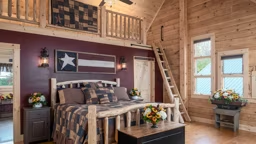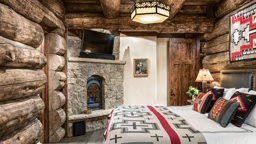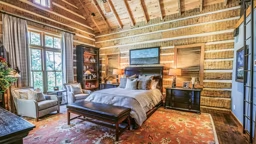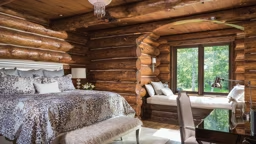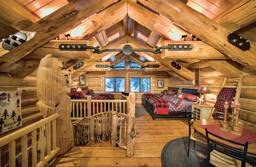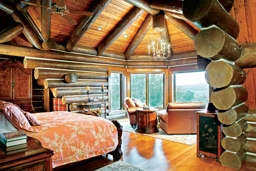 A hundred years ago, the bedroom was a very private affair. The old-fashioned boudoir was often tucked away on a second story, visited only at nighttime when slumber called. Today, the master bedroom has come out of hiding and into the limelight. No longer just a place to hang one's robe, the master bedroom has evolved into a chamber that is used for far more than sleeping. "I like to think of the master bedroom as a place for refuge as well as a place for privacy and sleep," says Bobby Nixon, director of design for Log Concepts & Building Systems of Plymouth, Wisconsin. "With a little bit of imagination and creative thinking, you can come up with many different ideas for maximizing its living space." While the modern-day master bedroom indeed has many uses, it's important to remember the primary focus of the room. "We really need rest, and the master bedroom is meant to be a place of rest," says architect Jean Steinbrecher of Langley, Washington. "Sometimes that idea gets lost in the large size and design of the master suite." With a little ingenuity, you can combine the best of both worlds and create a master suite that's both a place of relaxation and a place for living. We've gathered 10 expert design ideas to help you make the most of your master suite while still maintaining its private character. As you design your dream room, strive for a sanctuary that offers respite from the pressures of everyday life. 1 Compartmentalize your space. Incorporating living space in a master suite can be overwhelming. After all, how do you create functional space in your bedroom without interfering with relaxation? Jean recommends compartmentalizing the space. "Consider a large alcove for a bed, or pull a curtain across an area for privacy," she suggests. "It's important to create separate areas so that several activities can go on at once without disturbance." While master bedrooms traditionally serve two people, they should be designed with an emphasis on the individual. "The master bedroom needs to incorporate a space for one," advises Bobby. "You need to ask yourself how you can carve out space or add space to create a private, individual sanctuary." 2 Go for a window seat. One way to carve out individual space is to incorporate a window seat. Choose a large window and design a built-in seating area that's comfortable and inviting. This special niche will quickly become a cozy spot for reading and relaxing. Some home owners opt to create a wide seat that doubles as a single bed, providing a spare sleeping space for a grandchild. Jean suggests incorporating drawers underneath to hold linens. Whether your window seat is simple or elaborate, be sure to line it with lots of pillows so that it is a comfortable retreat. Bobby says it's also important to consider views and lighting. "The most memorable window seat I ever encountered was at a monastery in Mexico," he says. "The space was carved out right in the wall to conform to the body, and it was situated in such a way that natural light would come in perfectly over your shoulder." 3 Add flair with French doors. A great way to open up the space in your master bedroom is to add a set of French doors. When both doors swing open, they visually expand a bedroom. They can be used as an indoor entry to a bedroom, or as a gateway to an outside deck or patio. When set on an outside wall, they visually extend the living space and bring the outdoors in. You can also use French doors within your master suite to help separate sleeping space and living space. For example, you may want to distinguish between a small office area and your sleeping quarters or a dressing area. French doors are incredibly functional and they add architectural flair. 4 Consider an office area. "Work" and "relaxation" are as opposite as night and day, but there are ways you can combine the two functions in one setting. "Depending upon the needs of a client, a small office area can easily be designed within a master suite," says Bobby. "If you're looking for a niche that's just big enough for a small desk and some books, it doesn't take a whole lot of space." An office area can be separated from your sleeping quarters with French doors, curtains, half-walls or partitions. Furniture?such as armoires and decorative screens?can also be used to disguise the office area. If you're looking for a very large office, consider putting it elsewhere in your house. But if you're looking for a small office area, the master bedroom may be just the place for it. 5 Create a small library. A cozy bedroom is the perfect place for reading. You can easily incorporate a small library area by choosing the right furnishings. Bobby suggests filling a large cabinet with books and fronting it with glass instead of wood doors. "This will help you keep it organized so it will look nicer; it will also protect your books from dust," he says. Built-in shelving is another good option. Jean proposes creating built-in shelves around a window seat. This will keep books organized and readily available. She also believes it's important to designate a private reading area. "It's nice to have a reading chair, a good lamp and a little side table for your tea cup," she says. 6 Don't forget what's underfoot. "People tend to forget about the most obvious places when they're decorating," says Bobby. "The floors are one of these forgotten areas." To add interest underfoot, consider mixing it up with different materials, such as wood, tile and carpeting. Jean advises against wall-to-wall carpeting. "You don't need it," she says. "It creates a lot of dust and this can be a problem for people with allergies. Consider using hardwoods with beautiful carpets or area rugs that can be taken up and cleaned regularly." In-floor radiant heating is also popular. "There's nothing like a warm floor," says Bobby. "The initial cost of radiant heating may be more up-front, but it is very energy efficient in the long run." 7 Incorporate a dressing room. In the past, a separate dressing area in the bedroom was a luxury feature found in very few homes. Today, it's a different story. "Dressing rooms are more in demand than a formal living room or dining room," says Bobby. "You can double up the uses of this space and really maximize its potential." One way to create a multi-function dressing room is to incorporate storage space within it. For example, instead of opting for a large walk-in closet (which takes up a lot of floor space), design a dressing room as a small hallway area that leads to a bath, and line the sides of this dressing hall with large closets on each side. Clothes will be close at hand for dressing, yet closet doors will keep the clutter out of sight. 8 Deck the walls. "People often overlook the treatment of walls," says Bobby, "and yet there are huge opportunities missed there." In a timber frame bedroom, wood beams will lend character and definition to drywall. Yet you can liven up ordinary white walls even more by decorating with stencils, faux finishes and wallcoverings. Introduce different textures to add more interest to the design. Don't be afraid to incorporate bright bursts of color that contrast with the wood tones. Artwork is also a big part of wall decor. Choose prints that complement the colors and themes of your bedroom. You can also frame family photos and vacation shots to bring in a more personal flavor. 9 Frame a view. When planning a master bedroom, it's important to think about the space and the view ahead of time. What will you see when you look out your bedroom window? Does an old shed obstruct your view of nature? Do you really want to be staring at a swimming pool every time you open up your curtains? You need to think about these issues in advance. You may want to hire a designer who will help you capture the best opportunities. If there is no spectacular view to capture?or you simply can't do anything about the view you currently have outside your window?you can still create your own perfect vista. Bobby suggests creating a "garden view" by planting bamboo plants on either side of a window and surrounding the window area with potted plants. The beautiful blooms will distract the eye from a less-than-perfect view outside, and you're sure to enjoy your own personal garden oasis. 10 Look up. The ceiling is another area that tends to be overlooked in the master bedroom. Many timber frame home owners get so caught up in the idea of vaulted ceilings that they forget to think about coziness. "Get those timbers down where you can see them," advises Jean. "It's so hard to feel sheltered in a room that's so tall with high ceilings. There are lots of other ways to think about it. I like flat ceilings." Ceilings can be brought back up, but you need to think about other decorating options that will help make the room feel cozier. Sponge painting or rag painting will help change the texture of the surface, and make the whole room feel more comfortable. Ceilings with a "woven" pattern of wooden slats will also add interest and texture to your master bedroom. Don't be afraid to try something a little out of the ordinary. "With the right planning and a little creativity," Bobby says, "the master bedroom can truly become an experience, a place where you can go to get away from the rest of the world." |
| Five Big Don'ts | |||
| When it comes to designing a master bedroom, there are a few things you should avoid. Architect Jean Steinbrecher of Langley, Washington, shares her top five master bedroom no-no's: "Don't store stuff under the bed. "In feng shui, they call this 'heavy energy,' and when we sleep, we want to be as light as possible," explains Jean. " Don't put a television in the room. In today's high-tech society, a television-free bedroom may be hard to imagine. "We really need to unplug and give ourselves a rest," says Jean. " Don't put a bathtub in the bedroom. A small whirlpool tub may be tempting, but most home owners find they seldom use it, and that it's a nuisance to keep clean. Save the tub for the bathroom. " Don't rely on decorative screens to keep out light or noise. Screens may be aesthetically pleasing and may help to separate some spaces, but they are not too effective at truly separating functional areas. "Don't put a large hot tub on a patio or deck directly off the master bedroom. Think about how other people will get to the hot tub?they will have to trek through your bedroom. Also, you probably won't appreciate the noise of other family members splashing out in the tub while you're trying to sleep. |
|||
| Quick Tip: Light it Right! | |||
| When planning the lighting in your master bedroom, be sure to incorporate some sort of bedside lamp that can be controlled from the bed (perfect for late-night reading). Set up many lamps throughout the room to provide a soft ambiance. In addition, you should include some sort of brighter overhead lighting that can be turned on when needed during dressing and cleaning. | |||
| Story by Stacy Durr Albert |




